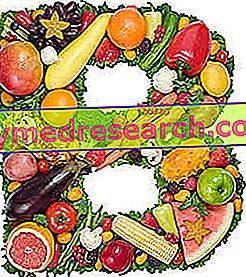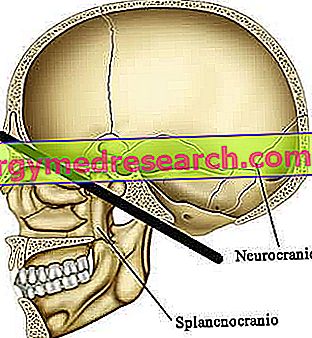Generality
The term vitamins derives from the word "amines of life", by virtue of the metabolic importance that these molecules have for the body. There are eight B vitamins and they represent most of the water-soluble vitamins that, including ascorbic acid (vitamin C), are in total nine.
They are B vitamins:
- Vitamin B1
- Vitamin B2
- Vitamin B3 or PP
- Vitamin B5
- Vitamin B6
- Vitamin B8 or H
- Vitamin Bc or folate
- Vitamin B12

Deficiency and Excess
The lack of B vitamins can lead to avitaminosis or hypovitaminosis; avitaminosis means the total absence of one or more vitamins, while hypovitaminosis is simply the partial deficiency of one or more of these molecules.
The excess (generally pharmacological) of vitamins can induce hypervitaminosis and consequent serious side effects.
Thermolabile Vitamins
One of the characteristics that almost all the B vitamins (and actually also vitamin C) have in common is thermolability; except for the vit. B2, B6 and (partially) B12, ALL the others are sensitive to heat. This means that cooking food reduces the overall vitamin content more or less significantly based on: 1. Chemical-physical characteristics of vitamin 2. Intensity / duration of heat treatment.
Light sensitivity
Unfortunately, temperature is not the only variable that affects the presence or absence of B vitamins in food; some of them are also photosensitive (vitamin B2, B6 and B8); therefore, their presence in foods depends on their exposure to light and the length and / or method of preservation. Furthermore, vitamin B1 or thiamine is particularly damaged by some food preservatives, a peculiarity that makes foods "in cans" further depleted of vitamins.
Antivitamine
As if that were not enough, the B vitamins must compete or undergo the action of other anti-nutritional molecules called ANTIVITAMINS; these active ingredients reduce the bioavailability of group B vitamins and hinder their use by the human body. These include: oxytiamine, juritiamine, thiaminase, antimalarial drugs, anti-conception drugs and anticonvulsant drugs (complete list of drugs that can cause deficiencies of B vitamins).
Nutritional intake
Ultimately, to guarantee your body a correct intake of B vitamins is essential:
- Know your own levels of recommended nutrient rations for the Italian population (LARN)
- Adapt these values to your individual needs, which may be different from the average for: competitive sports, special physiological conditions, acute or chronic malabsorption, hepatitis, alteration of intestinal flora, alcoholism, infections, etc.
- Identify any anti-vitamin drugs or molecules to counteract the anti-nutritional effect
- IN RESPECT of hygiene and food regulations, prefer raw, undercooked foods, cooked only superficially, NOT stored in jars and intact (therefore not spoiled)
- If necessary, supplement the power supply with over-the-counter or pharmaceutical products (although injections are rarely necessary)
Food Sources and Functions
Vitamin B1
Vitamin B1 ( thiamine or aneurine ): also known as anti-beriberic, it is mainly found in whole grains (but not much in refined ones), in wheat germ, in legumes, in liver, in molluscs and in mushrooms. Like many other B vitamins, it plays the role of coenzyme (in the metabolism of carbohydrates) as well as influencing nerve impulse transmission and intervening in the metabolism of ethyl alcohol.
Vitamin B2
Vitamin B2 ( riboflavin ): from the anti-dermatitis property, it is commonly found in foods of animal origin (in the liver, in eggs, in milk, in fish) and in whole grains or mushrooms. It is a coenzymatic constituent (FAD and FMN) and also participates in the maintenance of mucous membranes.
Vitamin PP
Vitamin B3 or PP ( nicotinic acid and nicotinamide ), defined as antipellagrosa, is found mainly in foods of animal origin (liver, poultry, meat, tuna and milk), but also in legumes; it can be synthesized starting from the essential amino acid tryptophan . It is a coenzyme constituent (NAD and NADP) and intervenes in the metabolism of lipids, glucides and proteins.
Vitamin B5
Vitamin B5 ( pantothenic acid ), also called growth, is contained in the liver, meat, whole grains, eggs, vegetables and nuts. In the tissues it is present in the form of coenzyme (CoA), an important element in the metabolism of lipids, glucides and proteins, as well as in the synthesis of cholesterol and steroid hormones.
Vitamin B6
Vitamin B6 ( pyridoxine, pyridoxal and pyridoxamine ) is also antidermatitic; found in: whole grains, liver, spinach, peas and bananas, and is a constituent of coenzymes that participate in the metabolism of amino acids.
Vitamin H
Vitamin B8 or vitamin H ( biotin and α-biotin), like B2 and B6, is antidermatitis. It is found mainly in egg yolk, in the liver, in the kidney, in green vegetables and in meat, but it is also synthesized by the intestinal bacterial flora. It forms a coenzyme useful in the synthesis of fats, amino acids and carbohydrates.
Folic acid
Vitamin Bc or folic acid ( pteroyl-glutamic acid ) has antianemic properties. It is contained in egg yolk, liver, kidneys, green vegetables, asparagus, wheat germ and legumes. It constitutes an essential element for: coenzymes of synthesis of nucleic acids and reproduction of red and white blood cells.
Vitamin B12
Vitamin B12 (cyanocobalamin), like Bc, is a vitamin of the B group with an antianemic action; it is stored in good quantities in the human liver and, in its ACTIVE form, is found exclusively in foods of animal origin: meat, eggs, fish, molluscs, liver, kidneys and milk. It goes to compose a coenzyme useful for different functions: together with Bc it synthesizes nucleic acids, determines the replication of red blood cells and promotes the functioning of the nervous system.



